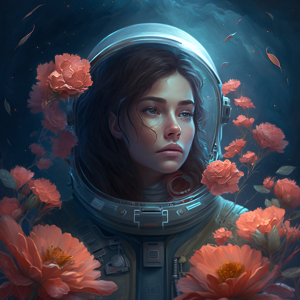AI art refers to the creation of artistic works through the use of artificial intelligence technologies. This innovative form of art often blurs the line between human creativity and machine learning algorithms.
Understanding AI Art
AI art encompasses a range of creative outputs, from paintings and drawings to music and poetry, all generated with the assistance of AI algorithms. These algorithms can analyze existing artworks to generate new pieces or work collaboratively with human artists to augment their creativity.
The Role of Machine Learning
Machine learning, a subset of AI, plays a pivotal role in AI art creation. Algorithms like neural networks can learn from a vast database of existing art and generate new works that reflect learned patterns and styles.
Generative Adversarial Networks (GANs)
One popular method for creating AI art is through Generative Adversarial Networks (GANs). These involve two neural networks, a generator and a discriminator, working in opposition to create and refine artistic outputs.
Human-AI Collaboration
In many instances, AI art results from a collaborative process where human artists provide initial inputs or frameworks, and AI algorithms expand upon them. This collaboration can yield results that neither humans nor AI could achieve independently.
Applications and Examples of AI Art
AI art finds its application in various fields, ranging from graphic design to music composition. For instance, AI-generated paintings have been auctioned at major art galleries, and AI-composed music has been performed at concerts.
AI Art in Popular Culture
AI-generated artwork is increasingly appearing in popular culture, including movie visuals, video game graphics, and even fashion design.
The Future of AI Art
As AI technology evolves, so too will the possibilities for AI art. This evolution could lead to more sophisticated and nuanced artworks, challenging our understanding of creativity and artistic expression.
Ethical and Philosophical Considerations
The rise of AI art raises questions about authorship, originality, and the role of human creativity in an increasingly digital world.
Technical Aspects of AI Art
Power and Efficiency
AI art creation, especially using advanced models like GANs, requires significant computational power. High-end GPUs and specialized hardware are often necessary to train and run these models efficiently.
Cost Implications
The cost of creating AI art varies greatly, depending on the complexity of the project and the computing resources required. For basic projects, the cost might be minimal, but for high-resolution, sophisticated artworks, it can escalate quickly.
Efficiency and Speed
The efficiency of AI art creation depends on the algorithm and hardware used. Some AI models can generate art in seconds, while others, particularly those dealing with high-resolution or complex compositions, might take longer.
Advantages and Limitations
Advantages
- Creativity Enhancement: AI can augment human creativity, offering new perspectives and ideas.
- High Productivity: AI can produce art quickly and in large quantities.
- Diverse Styles: AI algorithms can mimic various artistic styles or even create new ones.
Limitations
- Originality Concerns: Questions arise about the originality of AI-generated art.
- Emotional Depth: AI may struggle to infuse art with deep emotional or personal resonance, a quality often found in human-created art.
- Technical Barriers: The technical complexity and cost of AI art creation can be prohibitive for some artists.
Lifespan and Durability
The digital nature of AI art ensures a potentially indefinite lifespan, unlike traditional art forms that may degrade over time. However, the durability of physical manifestations of AI art, like printed artworks, is subject to the quality of materials used.
Material and Quality Considerations
AI art, when transformed into physical forms, relies on the quality of materials like canvas, paper, and inks for prints. The choice of these materials affects the artwork's longevity and visual appeal.
Conclusion
AI art represents a dynamic and evolving field that intersects technology and creativity. As AI technology advances, it will continue to challenge and redefine the boundaries of art.
